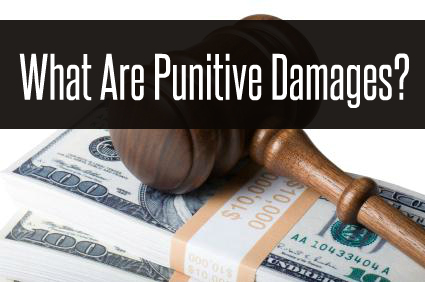Punitive damages are damages awarded in a civil suit that are in addition to compensatory damages. Compensatory damages are meant to restore the plaintiff to their position before the other party injured them. Typically, compensatory damages would cover medical treatment or bills to repair damage to a car or house. Punitive damages are very different because they place the plaintiff in a position better than they were before. In some cases, punitive damages can be several hundred thousand or even millions of dollars and can be very lucrative for a successful plaintiff.
The Goal of Punitive Damages
The goal of compensatory damages is to compensate the plaintiff for the injuries or damage suffered. The goal of punitive damages, on the other hand, is to punish the other party and discourage them or similar actors from taking similar actions in the future. Punitive damages are actually meant to benefit society by discouraging bad behavior.
Because punitive damages have a much broader goal and can be a lot more expensive, they are only awarded in special circumstances. According to Justia.com, courts only award punitive damages if the conduct was clearly intentional, done with malice, or was very outrageous and reckless. Maryland actually has very strict rules regarding punitive damages. To award punitive damages in Maryland, the plaintiff must show that the other party had “actual malice,” or prove that the wrongdoing was conscious and intentional.
For example, if a company’s reckless actions to increase profits were unnecessarily putting the safety of its workers and customers at risk, then there may be punitive damages in certain states, but maybe not in Maryland. Another example would be if a company was intentionally misleading or lying to customers in order to increase their profits. That situation might also lead to punitive damages in Maryland as well as other states.
As you can see, punitive damages are normally only involved with cases involving corporations or other large organizations.
How are Punitive Damages Calculated?
Compensatory damages are based on what the negligent or improper actions cost the plaintiff, so they are generally simpler to calculate and justify. Punitive damages are subjective, so there are not always hard and fast rules to determine how much to award. Generally they are calculated based on the compensatory damages and can be a multiple, such as double or triple the compensatory damages. In other cases, they can be a flat amount such as $1 million.
Because punitive damages are more subjective and can sometimes become excessive, some states have passed laws that limit punitive damages. Sometimes these laws establish a strict cap, and sometimes they establish that punitive damages cannot exceed double or triple the compensatory damages. Some states also limit punitive damages for certain types of cases.
According to LawInfo.com, there is no general cap for punitive damages in Maryland, but there is a punitive damages cap in medical malpractice suits. Have you been recently injured or suffered damage due to another party’s reckless and intentional actions? If so, you should contact an attorney immediately. The attorneys Ingerman & Horwitz can help you get compensation for your injuries as well as seek punitive damages for the outrageous behavior.













